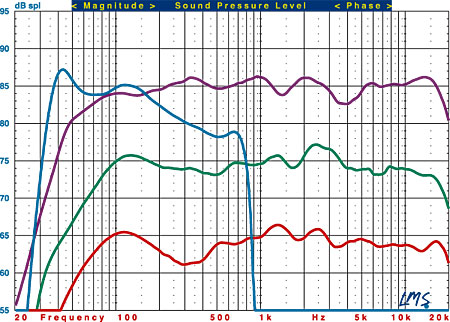- Joined
- Sep 10, 2019
- Messages
- 251
- Likes
- 312
A friend had an extremely cheap "subwoofer" going spare in his basement and suggested I try using it with my desktop speakers (Era Design 5). I'm using miniDSP 2x4HD to do crossovers and such, but tried 'wide open' measurements on L, R and sub. I matched the sub to the speakers by ear, and we're not measuring super loud here. Microphone position was roughly head position seated at the desk, <1m from all drivers.
As I look at these measurements, I see very little 'subwoofer' content at all. I'm not certain the degree to which the room is affecting these, but I am missing a fundamental tone from the sub until closer to 50Hz.
By ear, the let's-call-it-a-bass speaker does seem to dig deeper than the satellites, but REW reports no fundamental tone but lots of harmonic distortion at lower frequencies. This definitely "thickens up" the bass in the 50-60hz range, but I'm debating whether or not this is a useful contribution.

"Bass speaker" distortion plot here:

Left Desktop Speaker Distortion Plot:

Red trace below is Sound & Vision quasi-anechoic response for the desktop speakers, which seems fairly well represented particularly in the blue trace above.

Bottom line question is: does this free bass speaker have any utility? It does appear to make some noise, but does it contribute anything beyond noise to try to integrate it?
As I look at these measurements, I see very little 'subwoofer' content at all. I'm not certain the degree to which the room is affecting these, but I am missing a fundamental tone from the sub until closer to 50Hz.
By ear, the let's-call-it-a-bass speaker does seem to dig deeper than the satellites, but REW reports no fundamental tone but lots of harmonic distortion at lower frequencies. This definitely "thickens up" the bass in the 50-60hz range, but I'm debating whether or not this is a useful contribution.
"Bass speaker" distortion plot here:
Left Desktop Speaker Distortion Plot:
Red trace below is Sound & Vision quasi-anechoic response for the desktop speakers, which seems fairly well represented particularly in the blue trace above.

Bottom line question is: does this free bass speaker have any utility? It does appear to make some noise, but does it contribute anything beyond noise to try to integrate it?


